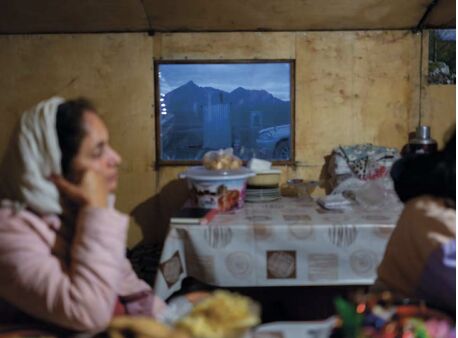It was the summer of discovery, and I was standing on the plains of Songkul, a high-altitude lake in Kyrgyzstan. The first time I’d visited, I was just a curious tourist. I didn’t expect to find inspiration for a research project. But then I met Rahima. She ran a yurt camp there, a resilient woman quietly building a better future for her family through entrepreneurship. Her calm strength, her ability to harness opportunity in the harshest of landscapes, stayed with me long after I left.
I knew I had to come back.
The second time, I was leading a team with the goal of learning from women like Rahima. When we reached the plains, I was eager to find her again. But Rahima wasn’t there. We searched the camp and asked around, feeling a little disoriented in that vast, quiet space. Then, in the distance, a four-wheel-drive vehicle kicked up dust as it sped across the steppe.
The car came closer, shining in the mountain sun, and out stepped Rahima herself. I still remember the moment she got out—graceful and proud. It told me more than any interview could. Rahima wasn’t just surviving; she was thriving, transforming not only her life but also her family's future, step by step. It was the moment I realized entrepreneurship isn’t just about business. It’s about empowerment, resilience, and rewriting life stories.
That moment also reshaped my role. I wasn’t just there to collect data and write another paper. I was there to tell Rahima’s story—and the stories of many other women like her. Yes, research papers are essential, but there’s a limit to how much they can convey. Data tables and p-values don’t carry the weight of these lived experiences. I wanted these women to see their own stories reflected back at them—not just as academic findings, but as narratives of strength and success.
This is why I began writing books of entrepreneurial narratives, taking visual anthropologists like Alexander Parkyn-Smith with me to capture the beauty and power of these women in their environments. We worked hard to craft these stories with care, confirming every detail with our respondents. We celebrated these stories through book launches and photo exhibitions, not just in university halls, but in the very villages and camps where they were born. Seeing the pride and joy in the eyes of Rahima and others—that’s when I truly understood what research impact can be.
In the coming weeks, I’ll be sharing a series of posts about this journey. These posts will highlight the stories of the incredible women entrepreneurs I met in Kyrgyzstan. I’ll reflect on how academia can (and should) do more to give power back to those whose stories shape our work.
I’m grateful for the opportunity to share this journey and hope it inspires you to embrace storytelling in research.
I knew I had to come back.
The second time, I was leading a team with the goal of learning from women like Rahima. When we reached the plains, I was eager to find her again. But Rahima wasn’t there. We searched the camp and asked around, feeling a little disoriented in that vast, quiet space. Then, in the distance, a four-wheel-drive vehicle kicked up dust as it sped across the steppe.
The car came closer, shining in the mountain sun, and out stepped Rahima herself. I still remember the moment she got out—graceful and proud. It told me more than any interview could. Rahima wasn’t just surviving; she was thriving, transforming not only her life but also her family's future, step by step. It was the moment I realized entrepreneurship isn’t just about business. It’s about empowerment, resilience, and rewriting life stories.
That moment also reshaped my role. I wasn’t just there to collect data and write another paper. I was there to tell Rahima’s story—and the stories of many other women like her. Yes, research papers are essential, but there’s a limit to how much they can convey. Data tables and p-values don’t carry the weight of these lived experiences. I wanted these women to see their own stories reflected back at them—not just as academic findings, but as narratives of strength and success.
This is why I began writing books of entrepreneurial narratives, taking visual anthropologists like Alexander Parkyn-Smith with me to capture the beauty and power of these women in their environments. We worked hard to craft these stories with care, confirming every detail with our respondents. We celebrated these stories through book launches and photo exhibitions, not just in university halls, but in the very villages and camps where they were born. Seeing the pride and joy in the eyes of Rahima and others—that’s when I truly understood what research impact can be.
In the coming weeks, I’ll be sharing a series of posts about this journey. These posts will highlight the stories of the incredible women entrepreneurs I met in Kyrgyzstan. I’ll reflect on how academia can (and should) do more to give power back to those whose stories shape our work.
I’m grateful for the opportunity to share this journey and hope it inspires you to embrace storytelling in research.


